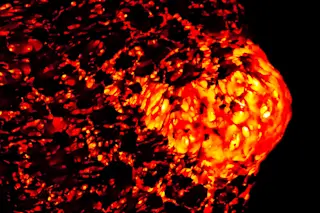Getty Images Every once in a while, we get some truly strange "volcano" news. This would count as strange: In Kirkuk, Iraq, video was captured of a "mini-volcano" appearing underneath a house (see below). The "eruption" was small, maybe a foot or two across with spattering lava and fumes. Al Arabiya reported that this pit of molten rock may have been created by an electrical fire underneath the building. The video shows that the ground isn't merely hot but actually molten.
#شطلعت_هاي وجود حمم بركانية وسط محافظة كركوك / هي عايزة ?? pic.twitter.com/Zpa8s9g9xr
— alialmajdie (@alialmajdie) July 29, 2016
If you're thinking "that's impossible", consider this: Electrical fires and arcing can reach temperatures of over 3000ºC
. If you even had a sustained electrical fire under the building that reached 1000-2000ºC, the quartz-rich, sandy material (especially if calcite is mixed with it, which is common in this area) under and ...














